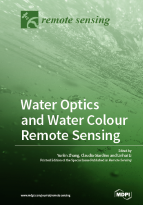Water Optics and Water Colour Remote Sensing
A special issue of Remote Sensing (ISSN 2072-4292).
Deadline for manuscript submissions: closed (28 February 2017) | Viewed by 184157
Special Issue Editors
Interests: lake optics and water color remote sensing; chromophoric dissolved organic matter (CDOM) biogeochemistry cycle; UV-B radiation environmental effect; physical limnology; lake eutrophication; lake thermodynamics
Special Issues, Collections and Topics in MDPI journals
Interests: imaging spectroscopy and remote sensing of lakes; bio-optical modelling; shallow waters; water quality monitoring
Special Issues, Collections and Topics in MDPI journals
Interests: hydrologic optics; optical remote sensing of inland and ocean waters; remote sensing inversion algorithms; radiative transfer of ocean; inelastic processes in the ocean
Special Issue Information
Dear Colleagues,
Available water resources, including rivers, reservoirs, lakes, coastal waters, and oceans, are emerging as a limiting factor, not only in quantity, but also in quality, for human development and ecological stability. Declining water quality has become a global issue of significant concern as anthropogenic activities expand and climate change threatens to cause major alterations to the hydrological cycle. Thus, monitoring the physical, chemical, and biological status of those waters are immensely important. Remote sensing has the potential to provide an invaluable complementary source of data at local to global scales. However, accurate, cost effective, frequent, and synoptic retrieval algorithms of in-water optical and biogeochemical parameters, as well as information on the biophysical properties have several challenges.
A Special Issue focusing on “water optics and remote sensing” is specifically aimed at addressing: (1) issues on water optics including characterizing optical properties among rivers, reservoirs, lakes, coastal waters, and open sea, modeling the relationships between apparent optical properties (AOPs) and inherent optical properties (IOPs); and (2) challenges on retrieval algorithm developments, validation, and applications of remote sensing of rivers, reservoirs, lakes, coastal waters, and open ocean. Obviously, this Special Issue will be helpful to update the recent progress in this rapidly growing research area.
The topics, examined at local, regional, or global scales, may include, but are not limited to, the following:
- Characterizing bio-optical properties of river, reservoir, lake, coastal and oceanic waters;
- Exploring the relationships between bio-optical properties and biogeochemical parameters;
- Development and validation of atmospheric correction algorithms;
- Model calibration and validation of optical and biogeochemical parameters;
- Mapping optical and water colour parameters from satellite and airborne data;
The Special Issue will consider invited contributed papers in response to an open call for papers. Contributions are expected from the research community focusing on algorithm development of water color and from the application community using the results obtained from remote sensing analysis.
Papers will be published continuously (as soon as they are accepted) and will be listed together on the Special Issue website. Research articles, review articles, as well as communications, are invited. Manuscripts should be submitted online at www.mdpi.com by registering and logging in to the website. Once you are registered, click https://susy.mdpi.com/user/manuscripts/upload?journal=remotesensing to go to the submission form. Manuscripts can be submitted until the deadline (1 December, 2016).
Dr. Yunlin Zhang
Dr. Claudia Giardino
Dr. Linhai Li
Guest Editors
Manuscript Submission Information
Manuscripts should be submitted online at www.mdpi.com by registering and logging in to this website. Once you are registered, click here to go to the submission form. Manuscripts can be submitted until the deadline. All submissions that pass pre-check are peer-reviewed. Accepted papers will be published continuously in the journal (as soon as accepted) and will be listed together on the special issue website. Research articles, review articles as well as short communications are invited. For planned papers, a title and short abstract (about 100 words) can be sent to the Editorial Office for announcement on this website.
Submitted manuscripts should not have been published previously, nor be under consideration for publication elsewhere (except conference proceedings papers). All manuscripts are thoroughly refereed through a single-blind peer-review process. A guide for authors and other relevant information for submission of manuscripts is available on the Instructions for Authors page. Remote Sensing is an international peer-reviewed open access semimonthly journal published by MDPI.
Please visit the Instructions for Authors page before submitting a manuscript. The Article Processing Charge (APC) for publication in this open access journal is 2700 CHF (Swiss Francs). Submitted papers should be well formatted and use good English. Authors may use MDPI's English editing service prior to publication or during author revisions.






